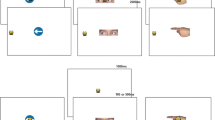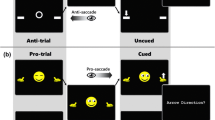Abstract
The present study investigates visual orienting to directional cues (arrow or eyes) in adults with high functioning autism (n = 19) and age matched controls (n = 19). A choice reaction time paradigm is used in which eye- or arrow direction correctly (congruent) or incorrectly (incongruent) cues target location. In typically developing participants, the visual orienting reflex is longer for eyes than for arrows. Right side cueing, but not left side cueing, induced a congruence effect for eyes, while this effect was evident for right as well as for left side arrow cues. In participants with autism the overall visual orienting reflex was not different between arrows and eyes and no laterality effect was found for eyes cueing. These findings suggest that, instead of a specific Eye Direction Detector persons with autism might have a general ‘Symbol Direction Detector’.
Similar content being viewed by others
References
InstitutionalAuthorNameAmerican Psychiatric Association (APA) (1994) Diagnostic and statistical manual of mental disorders DSM IV NumberInSeries4th edn American Psychiatric Association Washington DC
S. Baron-Cohen (1994) ArticleTitleHow to build a baby that can read minds: Cognitive mechanisms in mindreading Cahiers de Psychologie Cognitive 13 513–552
S. Baron-Cohen H. Ring (1994) A model of the mindreading system: Neuropsychological and neurobiological perspectives Lewis Mitchell (Eds) Children’s early understanding of mind (chapt. 9) Lawrence Erlbaum Associated Hove
S. Baron-Cohen (1995a). Midblindness: An essay on autism and theory of mind. MIT Press
S. Baron-Cohen (1995b) The eye detection detector (EDD) and the shared attention mechanism (SAM): two cases for evolutionary psychology C. Moore P. J. Dunham (Eds) Joint attention Lawrence Erlbaum Associates Hillsdale 41–59
S. Baron-Cohen R. Campbell A. Karmiloff-Smith J. Grant J. Walker (1995) ArticleTitleAre children with autism blind to the mentalistic significance of the eyes? British Journal of Developmental Psychology 13 379–398
S. Baron-Cohen D. Baldwin M. Crowson (1997) ArticleTitleDo children with autism use the speaker’s direction of gaze strategy to crack the code of language? Child development 68 48–57
Batki, A., Baron-Cohen, S. Wheelwright, S., Connelan, J., & Ahluwalia, J. (2000). Is there an innate gaze module? Evidence from human neonates. Infant Behavior and Development, 23, 223--229.
S. Bentin T. Allison A. Puce E. Perez G. McCarthy (1996) ArticleTitleElectrophysiological studies of face perception in humans Journal of Cognitive Neuroscience 8 551–565
J. A. Burack J. T. Enns J. E. A. Stauder L. Mottron B. Randolph (1997) Attention and autism: Behavioral and electrophysiological evidence D. J. Cohen F. R. Volkmar (Eds) Handbook of autism and pervasive developmental disorders John Wiley & Sons, inc New York
G. Butterworth N. Jarret (1991) ArticleTitleWhat minds have in common in space: spatial mechanisms serving joint visual attention in infancy British journal of developmental psychology 9 55–72
J. Bruner (1983) Childs’s talk Norton New York
K. Charwarska A. Klin F. Volkmar (2003) ArticleTitleAutomatic attention cueing through eye movement in 2-year-old children with autism Child development 74 1108–1122
S. D. Christman M. D. Hackworth (1993) ArticleTitleEquivalent perceptual asymmetries for free vieuwing of positive and negative emotional expressions in chimeric faces Neuropsychologia 31 621–624
G. Dawson S. Webb G. D. Schellenberg S. Dager S. Friedman E. Aylward T. Richards (2002) ArticleTitleDefining the broader phenotype in autism: Genetic, brain, and behavioral perspectives Development and Psychopathology 14 581–611
J. Driver G. Davis P. Ricciardelli P. Kidd E. Maxwell S. Baron-Cohen (1999) ArticleTitleGaze perception triggers reflexive visuospatial orienting Visual Cognition 6 509–540
T. Farroni G. Csibra M. Simion Johnson (2002) ArticleTitleEye contact detection in humans from birth Proceedings of the National academy of sciences 99 9602–9695
T. Farroni M. H. Johnson M. Brockbank F. Simion (2000) ArticleTitleInfants’ use of gaze direction to cue attention: The importance of perceived motion Visual Cognition 7 705–718
T. Farroni E. M. Mansfield C. Lai M. H. Johnson (2003) ArticleTitleInfants perceiving and acting on the eyes: Tests of an evolutionary hypothesis Journal of Experimental Child Psychology 85 199–212
C. K. Friesen A. Kingstone (1998) ArticleTitleThe eyes have it? reflexive orienting is triggered by non-predictive gaze Psychonomic Bulletin & Review 5 490–495
A. Friesen C. K. Kingstone (2003) ArticleTitleAbrupt onsets and gaze direction cues trigger independent reflexive attentional effects Cognition 87 B1–B10
J. N. Geest ParticleVan der C. Kemner M. N. Verbaten H. Engeland (2002) ArticleTitleGaze behavior of children with pervasive developmental disorder toward human faces: a fixation time study Journal of Child Psychology and Psychiatry 43 669–678
C. Gilbert P. Bakan (1973) ArticleTitleVisual asymmetry in perception of faces Neuropsychologia 11 355–362
Goldberg, M. C., Lasker, A. G., Zee, D. S., Garth, E., Tien, A., & Landa, R. (2002). Deficits in the initiation of eye movement in the absence of a visual target in adolescents with high-functioning autism. Neuropsychologia, 40, 2039–2049..
J. K. Hietanen (1999) ArticleTitleDoes your gaze direction and head orientation shift my visual attention? NeuroReport 10 3443–3447
J. K. Hietanen J. M Leppanen (2003) ArticleTitleDoes facial expression affect attention orienting by gaze direction cues? Journal of Experimental Psychology: Human Perception and Performance 29 1228–1243
E. A. Hoffman J. V. Haxby (2000) ArticleTitleDistinct representation of eye gaze and identity in the distributed human neural system for face perception Nature Neuroscience 3 80–84
B. M. Hood J. D. Willen J. Driver (1998) ArticleTitleAdult’s eyes trigger shifts of visual attention in human infants Psychological Science 9 131–134
M. H. Johnson S. H. Dziurawiec Ellis J. Morton (1991) ArticleTitleNewborns’ preferential tracking of face-like stimuli and it’s subsequent decline Cognition 40 1–19
M. A. Howard P. E. Cowell J. Boucher P. Broks A. Mayes A. Farrant N. Roberts (2000) ArticleTitleConvergent neuroanatomical and behavioural evidence of an amygdala hypothesis of autism Neuroreport 11 2931–2932
R. Kawashima M. Sugiura T. Kato A. Nakamura K. Hatano K. Ito (1999) Brain 122 779–783
A. Kingstone D. Smilek J. Ristic C. K. Friesen J. D. Eastwood (2003) ArticleTitleAttention researchers: It is time to take a look at the real world Current Directions in Psychological Science 12 176–180
A. Klin W. Jones R. T. Schultz F. R. Volkmar D Cohen (2002a) ArticleTitleVisual fixation patterns during viewing of naturalistic social situations as predictors of social competence in individuals with autism Archives of General Psychiatry 59 809–816
A. Klin W. Jones R. Schultz F. R. Volkmar D. J. Cohen (2002b) ArticleTitleDefining and quantifying the social phenotype in autism American Journal of Psychiatry 33 763–769
D.W. Kraijer (1999) handleiding AVZ-R, Autisme- en Verwante stoornissenschaal-Z-Revisie. Handleiding (3e herziene en uitgebreide uitgave) Swets Zeitlinger Lisse
S. R. H. Langton V. Bruce (2000) ArticleTitleYou must see the point: Automatic processing of cues to the direction of social attention Journal of Experimental Psychology: Human Perception and Performance 26 747–757
S. R. Leekham S. Baron-Cohen D. Perett M. Milders S. Brown (1997) ArticleTitleEye-direction detection: A dissociation between geometric and joint attention skills in autism Journal of Developmental Psychology 15 77–95
S. R. Leekham E. Hunisett C. Moore (1998) ArticleTitleTarget and cues: gaze following in children with autism Journal of Child Psychology and Psychiatry 39 951–962
S. R. Leekham B. Lopez C. Moore (2000) ArticleTitleAttention and joint attention in preschool children with autism Journal of autism and developmental psychology 36 261–273
E. M Mansfield T. Farroni M. H. Johnson (2003) ArticleTitleDoes gaze perception facilitate overt orienting? Visual-Cognition 10 7–14
C. Moore V. Corkum (1998) ArticleTitleInfant gaze-following based on eye-direction British journal of developmental psychology 16 495–503
McPartland J., Dawson G., Carver L., & Panagiotides H. (2001a, April). Neural correlates of face perception in autism. Poster presented at the Meeting of the Society for Research in Child Development, Minneapolis, MN.
McPartland J., Dawson G., Carver L., & Panagiotides H. (2001b, November). Neural correlates of face perception in individuals with Autism Spectrum disorder, Poster presented at the International Meeting for Autism Research San Diego, CA.
S. Parks (1983) ArticleTitleThe assessment of autistic children: A review of available instruments Journal of Autism and Developmental Disorders 13 255–267
Pelphrey, K. A., Sasson. N. J., REznicl, J. S., Paul, G., Goldman, B. D., & Piven, J. (2002). Visual scanning of faces in autism. Journal of Autism an Developmental Dsiorders, 32, 249--261.
P. Riciardelli T. Ro J Driver (2002) ArticleTitleA left visual field advantage in perception of gaze direction Neuropsychologia 40 769–777
Ristic, J., Friesen, C., & Kingstone, A. (2002). Are eyes special? It all depends on how you look at it. 507--513.
R. T. Schultz I. Gauthier A. Klin R. Fulbright A. Anderson F. R. Volkmar P. Skudlarski C. Lacadie D. J. Cohen J. C. Gore (2000) ArticleTitleAbnormal ventral temporal cortical activity among individuals with autism and Asperger syndrome during face discrimination Archives of General Psychiatry 57 331–340
B. Schultz (2003) What do imaging studies tell us about the neural basis of autism G. J. Bock Goode (Eds) Autism, Neural basis and treatment possibilities Novartis Foundation Wiley (Chichester) 149–166
J. Swettenham A. Condie R. Campbell E. Milne M. Coleman (2003) ArticleTitleDoes the perception of eyes trigger reflexive visual orienting in autism Phylosophical Transactions of the Royal Society, Series B 358 325–334
J. Tipples (2002) ArticleTitleEye gaze is not unique: automatic cueing to uninformative arrows Psychonomic Bulletin & Revieuw 9 314–318
Tomasello, M. (1995). Joint attention as social cognition. In C. Moore & P. Dunham (Eds.), Joint attention: Its origins and role in development (pp. 103--130).
M. Tomasello A. C. Kruger H. H. Ratner (1993) ArticleTitleCultural learning Behavioral and Brain Sciences 16 495–552
M. Tomasello and J. Call (1997). Primate Cognition Oxford University Press
C. Trepagnier M. M. Sebrechts R. Peterson (2002) ArticleTitleAtypical face glaze in autism CyberPsychology and Behavior 5 213–217
Vinette, C., Gosselin, F., & Schyns, P. G. (in press). Spatio-temporal dynamics of face recognition in a flash: It’s in the eyes? Cognitive Science.
Volkmar, F. R., & Mayes, L. C. (1990). GAze behaviour in autism. Development and Psychopathology, 2, 59--87.
S. Watanabe K. Miki R. Kakigi (2002) ArticleTitleGaze direction affects face perception in humans Neuroscience Letters 325 163–166
B. Wicker F. Michel M. A. Henaff J. Decety (1998) ArticleTitleBrain Regions involved in the perception of gaze: a PET study Neuroimage 8 221–228
Author information
Authors and Affiliations
Corresponding author
Rights and permissions
About this article
Cite this article
Vlamings, P.H.J.M., Stauder, J.E., van Son, I.A.M. et al. Atypical Visual Orienting to Gaze- and Arrow-Cues in Adults with High Functioning Autism. J Autism Dev Disord 35, 267–277 (2005). https://doi.org/10.1007/s10803-005-3289-y
Issue Date:
DOI: https://doi.org/10.1007/s10803-005-3289-y




